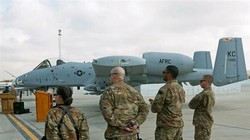 UN sources reveal that the United States is planning to carry out a “tactical assault” on an Iranian nuclear facility in response to recent attacks on two tankers in the Sea of Oman, which Washington and some of its allies blamed on Tehran without providing any credible evidence.
UN sources reveal that the United States is planning to carry out a “tactical assault” on an Iranian nuclear facility in response to recent attacks on two tankers in the Sea of Oman, which Washington and some of its allies blamed on Tehran without providing any credible evidence. RNA - Diplomatic sources at the United Nations headquarters in New York told the Hebrew-language Israeli newspaper Maariv that they are weighing the United States’ plans to conduct the assault.
According to the officials, the White House has been holding incessant discussions involving senior military commanders, Pentagon representatives and advisers to US President Donald Trump since Friday, the Jerusalem Post reported.
It quoted the officials as saying that the US military action would probably include an aerial bombardment of an Iranian facility linked to its nuclear program.
“The bombing will be massive but will be limited to a specific target,” a Western diplomat said.
According to the sources, Trump himself was not enthusiastic about a military strike against Iran, but had lost his patience on the issue and yielded to Secretary of State Mike Pompeo’s pressure, who has been pushing for a military attack.
Pompeo is scheduled to visit US Central Command at the MacDill Air Force Base, in Tampa, Florida, on Tuesday to discuss “regional security concerns and ongoing operations.”
One Japanese-owned and one Norwegian-owned tanker were struck by explosions near the strategic Strait of Hormuz on June 13. Tokyo said both vessels were carrying “Japanese-related” cargo.
The attacks took place just as Prime Minister Shinzo Abe of Japan was meeting with Leader of the Islamic Revolution Ayatollah Seyyed Ali Khamenei in Tehran.
Iranian Foreign Minister Mohammad Javad Zarif highlighted the timing of the incidents at sea, stressing that the attacks were suspicious.
Shortly after the incidents, the US secretary of state blamed Iran, without offering any convincing evidence.
Tehran has vehemently rejected any role, suggesting that the incidents might have been a false flag designed by the US to put even more pressure on Iran.
The US released a grainy video hours after the attack, purportedly showing “Iranian sailors” removing a mine from the Japanese-owned Kokura Courageous’ hull earlier in the day.
The video — which was supposed to serve as “evidence” of Iranian involvement in the incidents — was strongly challenged by experts and Washington’s own allies.
German Foreign Minister Heiko Maas said the video is not sufficient to prove the claim that Iran had been behind the attacks.
Tokyo, in turn, dismissed the US’s claim that Iran had attacked the tankers, according to Japanese officials.
A Japanese government source referred to the Iraq war, which the United States initiated after intelligence analyses of Iraq falsely pointed to the country possessing weapons of mass destruction.
Kremlin spokesperson Dmitri Peskov also reminded the US of the Iraq story, saying that history should serve as a cautionary tale against rushing into war again.
“We didn’t forget the vials with white powder. We remember and, therefore, have learnt to show restraint in our assessments,” Peskov said.
To support its claims, Washington on Monday released new images of the purported mine-removing operation, after its “evidence” failed to convince the international community of an alleged Iranian role. Those images, however, do not seem to be offering anything new.
Tensions have been running high in the region as the United States has recently taken a quasi-warlike posture against Iran. The Pentagon announced on Monday that the US will send 1,000 additional US forces and more military resources to the Middle East.
Such deployments began in May when the US sent an aircraft carrier strike group to the region along with Patriot missile batteries, among other reinforcements, citing alleged Iranian threats.
Tehran has time and again said that it won’t initiate any war with any state, but will give a crushing response to any act of aggression and defend the nation’s interests.
847/940